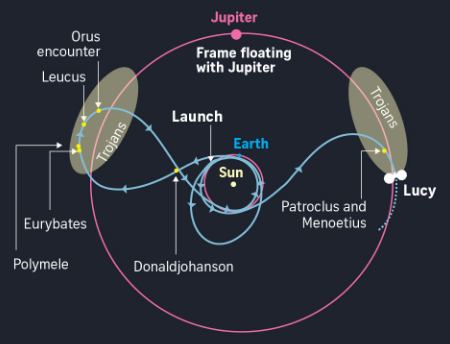Lucy: First Mission to Trojan Asteroids
- 18 Oct 2021
On 16th October 2021, Lucy spacecraft was launched from Cape Canaveral Space Force Station in Florida, USA.

(Image Source: straitstimes.com)
- Lucy will be the first spacecraft to study Jupiter's Trojan Asteroids.
- As well as the Trojans, Lucy will do a fly-by of an asteroid in the solar system’s main asteroid belt, called Donald Johanson in honor of the lead discoverer of the fossilized human ancestor known as Lucy, from which the NASA mission takes its name.
- The fossilized human ancestor, "Lucy," whose skeleton provided unique insight into humanity's evolution – Lucy will revolutionize our knowledge of planetary origins and the formation of the solar system. The Lucy fossil, unearthed in Ethiopia in 1974.
- Over the next 12 years, Lucy will fly by one main-belt asteroid and seven Trojan asteroids, making it the NASA’s first single spacecraft mission in history to explore so many different asteroids. Lucy will investigate these “fossils” of planetary formation up close during its journey.
- Lucy mission will allow scientists to explore two swarms of Trojan asteroids that share an orbit around the Sun with Jupiter.
What are Trojan Asteroids?
- Scientific evidence indicates that Trojan asteroids are remnants of the material that formed giant planets.
- The term "Trojan Asteroid" specifically refers to the asteroids co-orbital with Jupiter. The term "Trojan asteroid" is normally understood to specifically mean the Jupiter trojans because the first Trojans were discovered near Jupiter's orbit and Jupiter currently has by far the most known Trojans.
What Insights we can achieve through Trojan Asteroids?
- Studying them can reveal previously unknown information about their formation and our solar system’s evolution in the same way the fossilized skeleton of Lucy revolutionized our understanding of human evolution.
Trojan Destinations that will be mapped by Lucy
- Lucy’s Trojan destinations are trapped near Jupiter’s Lagrange points – gravitationally stable locations in space associated with a planet’s orbit where smaller masses can be trapped. One swarm of Trojans is ahead of the gas giant planet, and another is behind it. The asteroids in Jupiter’s Trojan swarms are as far away from Jupiter as they are from the Sun.
How Lucy will Encounter Trojan Asteroids?
- Lucy, the asteroid probe will make spaceflight history in another way - following a route that circles back to Earth three times for gravitational assists:
- 2022: The spacecraft’s first Earth gravity assist in 2022 will accelerate and direct Lucy’s trajectory beyond the orbit of Mars.
- 2024: The spacecraft will then swing back toward Earth for another gravity assist in 2024, which will propel Lucy toward the Donaldjohanson asteroid – located within the solar system’s main asteroid belt – in 2025.Lucy will then journey toward its first Trojan asteroid encounter in the swarm ahead of Jupiter for a 2027 arrival.
- 2031: After completing its first four targeted flybys, the spacecraft will travel back to Earth for a third gravity boost in 2031, which will catapult it to the trailing swarm of Trojans for a 2033 encounter.




